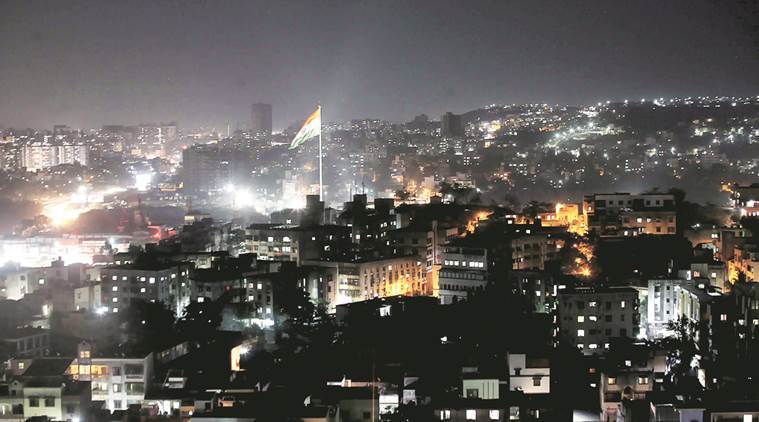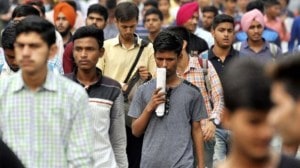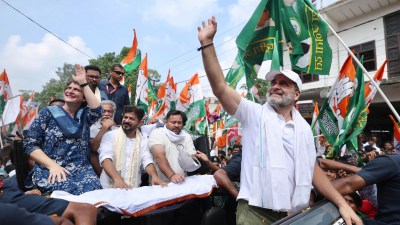What 2017 has in store for Puneites
Work on a new airport and a Metro line, a vibrant art festival, a civic election which may not highlight local issues, and continuing to live with demonetisation. Five of the city’s prominent residents speak about what lies ahead for Pune in the new year.
 Here’s To A Great 2017: The city in a festive mood, as it counts down to a brand new year. (Source: Pavan Khengre)
Here’s To A Great 2017: The city in a festive mood, as it counts down to a brand new year. (Source: Pavan Khengre)
2017, as I see it: Pune Metro
Affordable, comfortable commute has many socio-economic benefits: Shashikant Limaye
PUNE and Pimpri-Chinchwad have a combined population of about 55 lakh. Spread over approximately 600 sq kilometres, the number of vehicles in the region has crossed the 31 lakh-mark, which includes approximately 24 lakh motorcycles and 5.5 lakh four-wheelers. Over the past six years, there has been a phenomenal increase of 80 per cent in the number of motorcycles, and a 90 per cent increase in the number of two-wheelers. Lack of efficient public transport is one of the major reasons for this phenomenal rise in personalised vehicles.
Watch What Else Is Making News:
Puneites are seeing severe traffic jams on their roads. Contribution of road transport to PM 10 levels has shot up to 36 per cent. The adverse effects of traffic jams and high levels of pollution on the health of daily commuters are now reaching worrying levels. Particularly, in winters, the situation is simply alarming.
The planners had foreseen this situation way back in 1998 and the first studies on the feasibility of the Mass Rapid Transit System (MRTS) were carried out by RITES. These studies were followed by five further traffic studies between 2003 and 2012. Each of these identified the need for implementing MRTS along the identified high-density corridors. In 2008-09, the Delhi Metro Rail Corporation prepared the detailed project report for Pune Metro Phase I comprising two corridors — PCMC to Swargate and Vanaz to Ramwadi — with a total length of about 32 km. But this remained a subject matter of several discussions and objections.
Instead of this, the construction of flyovers and BRTS projects went ahead. But their efficacy in dealing with, and solving the problem of public transport, is by now well-known to every commuter. It is heartening to note that the long-awaited project has been approved and is on the verge of implementation.
With the formation of the Pune Metropolitan Region, spread over an area of 6900 sq km, the population of the region is projected to grow rapidly and reach a staggering 1.1 crore by 2031… nobody can stop this onslaught of rapid urbanisation. Planning and implementing a comprehensive mobility solution for the region is the need of the hour.
This will comprise several elements in addition to MRTS (Metro) such as (i) 200 wide ring roads, (ii) Well-planned BRTS systems, (iii) Efficient feeder bus systems leading to BRTS and Metro, (iv) Suburban rail corridors, (v) A new civil airport, (vi) Inter-state and local bus terminus, (vii) Inter-modal transit centres (viii) Facilities for autos and bicycles (ix) Parking lots.
The Pune Metro needs to be looked at as the backbone of the mobility plan. It is going to touch the life of every local resident after its commissioning, as has been the experience of Delhi Metro.
Affordable, reliable, comfortable and faster travel between home and office leads to several socio-economic benefits, which are difficult to quantify in monetary terms. The experience of Delhi Metro over the past 15 years reveals the following benefits :
(i) Lesser travel time allows local residents the option of looking for better jobs at faraway places. (In Pune, travel time between Swargate to PCMC or Vanaz to Ramwadi will reduce to 35 minutes from the present 1 hour, 30 minutes it takes during peak hours)
(ii) Lesser travel time and comfortable travel gives employees the option of living at faraway places, where better living standards can be enjoyed at much lesser costs.
(iii) The reliability and punctuality of the system enables people to optimise their time schedule, allowing more time for relaxation.
(iv) The class-less Metro Train ensures that everyone travels together, with the same level of comfort.
(v) Reduction in carbon emissions leads to better air quality.
Obviously, for such a world-class Metro system, people must be prepared to undergo some temporary pain during its construction. But with MahaMETRO, a public sector company of the Maharashtra government and the Centre, being assigned the responsibility for the execution and commissioning of Pune Metro, it is expected that the implementation will be speedy and cause minimum pain to citizens.
(Shashikant Limaye is former OSD, Pune Metro Project and former chief engineer, Indian Railways)
2017, as I see it: Banking
Jugaad will continue, demonetisation or no demonetisation: Achintan Bhattacharya
2016 was an eventful year, no doubt. Towards the end, over the last two months, we received the jolt of demonetisation. TV channels and newspapers pointed out the difficulties and follies, but there was an unusual amount of patience among the people who stood in ATM queues and at banks. I didn’t see any of the elites in the queue, nor do I hope to meet them near ATMs in 2017. So, ‘jugaad’ will continue in 2017, demonetisation or no demonetisation.
As for me, I am happy and an optimist as ever, as there is no quota or price tag or sarkaari circular no. 74 quantifying how much I can withdraw from my dream portfolio. I am sure 2017 will continue to be a generously good and engaging year for revenue officials whose empire has suddenly expanded. Their entire third quarter credit business having been wiped out, banks will have another washout of the final fourth quarter in 2017, their NPAs will continue to increase and fragilities will further grow for the economy as well.
In 2017, employees in PSBs would continue to face the collateral damage as a victim of demonetisation; they will be treated more like government employees in a subordinate office of the DFS. Sixty six years after freedom, our economic intelligence/CBI/or revenue officials still don’t ‘know beyond reasonable doubt’ who launders our money and, therefore, they will prefer to remain in that blissful state in 2017 as well.
In 2017, bankers will need training in crowd management, in police training colleges, as part of a risk management course.
In 2017, there will be more and more reform measures, more Jan Dhan Accounts, more Aadhar numbers than the population, and more coverage of Indian economy’s 7%+ growth potential in WSJ. Inflation numbers are likely to remain subdued and senior citizens will find their savings yielding dwindling returns. Cash-rich over-leveraged corporates will still not repay their NPAs.
In 2017, surely, politicians will continue to have their fun in exclusive clubs and amass funds in the same way as in the past year and political donations will never be made subject to scrutiny. Digital entrepreneurs will walk smiling to their bank accounts; cash will still be the king in bullion, gold, jewellery and real estate.
Well, our spouses will not be able to save from our purses or monthly kitty’, as I shall continue to use more credit cards, pay more service charges to Visa, Mastercard, Paytms et al. 2017 will still be a little less boring same-year for me and for the Indian economy.
(Achintan Bhattacharya is Director, NIBM)
2017, as I see it: New airport
An independent airport for Pune is the only solution for the woes of passengers: SK Jain
We appreciate the government’s move of identifying land at Purandar and taking positive steps in the direction of establishing an independent, international airport for Pune. This is a much-awaited action of the government. We have been waiting for such a positive move for the last 20 years. We fully support the government’s decision and initiative.
But, setting up an international airport is not an easy task. There could be many obstacles and delays along the way, which we expect the government to foresee and resolve. The proposed Navi Mumbai Airport has been facing many obstacles and is still trying to fight them out. Let it not happen to the Pune airport.
The Lohegaon airport is already bursting at its seams, as it has reached its limit in terms of utility. A defence airport, it has many restrictions for civilian flights, although the Air Force is very sympathetic towards civilian needs.
An independent airport for Pune is the only solution to the problems and woes of the passengers. The Purandar airport, once it is completed, will boost the economy, not only of Pune but the entire region. It has the capacity to become the cargo hub and benefit farmers, industries and trade. It will help industries from Pune, which send/receive material to and from Mumbai for exports/imports, as also for domestic movement. The Pune facility will ease the business for engineering, food and pharmaceutical industries. The international airport will boost the tourism industry, which will, in turn, help the hospitality sector as well.
Besides, when Pune has been designated as a Smart City, how can a Smart City not have its own independent international airport? This airport will ensure 24-hour operations and a lot of direct flights from and to international destinations, as well as domestic ones.
We look forward to the new airport being completed as soon as possible. This will greatly help the ease of doing business with Pune. Direct connectivity with major destinations in the country, and abroad, will make people’s lives easier and Pune can truly be called a Smart City.
(S K Jain is former president, Mahratta Chamber of Commerce and Industries)
2017, as I see it: civic polls
National, state issues will dominate PMC and PCMC polls: Vivek Velenkar
Elections for Pune and Pimpri-Chinchwad municipal corporations, in February 2017, would be markedly different for various reasons. The four-member panel will leave little or no chance for independents or rebel candidates as people will vote strongly on party lines. Also, the 80,000-plus panels will ensure that instead of local issues, national and state issues dominate the polls.
The geographical constructions of the wards, as well as the necessity of four members, is going to sound the death knell of independent candidates. The way wards have been redrawn has virtually eliminated the chances of local strongmen. Instead, there would be just pockets of influence of political parties, which the candidates will try to cash in on. The recent phenomenon of party-hopping that we are witnessing is because of strong candidates from weak parties trying to get to greener pastures.
A resurgent BJP will certainly try to wrestle power, both in Pune and Pimpri Chinchwad, while the MNS and the Congress, at this juncture, appear to be the weakest among all the players.
Due to the large size of the electorates, these local body elections will be dominated mostly by national and state issues. To cite just one example, the assembly segments of Goa are drawn with the electorate strength of 40,000 and the wards in Pune and Pimpri-Chinchwad have been drawn with electorate strengths of 80,000. Local issues are visibly absent and instead, national issues such as demonetisation are playing up. If the demonetisation mess continues to play up, it would be a major issue for the election.
It remains to be seen what part money plays in these elections. Due to demonetisation, every one is short of ready cash and the larger wards will necessitate deep-pocket spending… these elections would see spending limits cross the Rs 10-15 crore mark easily. So, only candidates with very deep pockets would be able to flex their moneypower.
The unfortunate part of this election would be the complete sidelining of local issues. Even as leaders join the campaign trail, issues such as garbage collection and disposal, the bus rapid transit system and streetlights remain absent from their speeches. Instead, national-level issues continue to be raised. Many parties have started reprinting their old manifestoes.
(Vivek Velankar, president of Sajag Nagarik Manch, had tried his hands in the 2012 civic elections. An RTI activist, Velankar spoke to Partha Sarathi Biswas)
2017, as I see it: art
Looks like a great beginning for visual art in Pune: Sujata Dharap
I have lived in Pune since 1985, after my post-graduation in art from the Sir J J School of Art in Mumbai. The art scene then was pretty slow and Pune barely had four art galleries. At the same time, Pune saw a great amount of performing arts, mainly music, theatre and literature. This thrived on a very high level and had an amazing audience for several decades. Visual arts, on the other hand, had few platforms and therefore did not create the right audience.
In the last few years, I am witnessing a sea change and it’s in these years that the city has seen lots of big and small galleries come up in all directions. The first city in India to host a Biennale, an international art festival, was Kochi. This year, it’s been a leap ahead with the work of eight artists from Pune being curated by Raju Sutar in a collateral event for the Kochi Biennale, called “Routes and Roots.”
The biennale took place in Pune for the first time in 2013 and then in 2015, where art became accessible to the common man, who was hesitant about visiting art galleries. Art came on to a public space and spread awareness about how to look at it and receive it. The coming year is going to start with the third edition of the biennale, from January 5 to 29.
This time, the flagship project called ‘Habit’ and ‘Co-habit’, curated by Zasha Colah and Luca Cherizza, will showcase installations by national and international artists from 40 cities and 20 nationalities. This will be a great exposure for the people of Pune, its students and art lovers. This awareness will help them experience art on a higher platform.
This entire process — to move along the entire J M Road and witness art, installations and interventions — will be a very different experience for Puneites. The J M Road, from Abil underpass to Garware bridge, will host the main part of this festival. It also includes the Pataleshwar temple, Jangli Maharaj temple, the Phule museum, and the PMC printing press. Apart from this, there are several participatory projects like “inclusive art”, which has workshops, camps and an exhibition of artists who are differently-abled.
Young Expressions hosts the work of art students from imminent schools from across the country. The Monalisa Kala Gram will host this show, which will enable students to interact with each other, exchange ideas and concepts and establish a visual dialogue. ‘Galleria’ will have mainly city artists showing their work in different art galleries in Pune. Several art galleries have joined hands under the umbrella of Pune biennale.
Three shows are specially designed for PMC galleries, namely Bal Gandharva Kala Dalan, Yeshwantrao Chavan and the Bhimsen Joshi Sabha Gruha. All these will be based on the theme of identity and self. Pune will be seeing more diversity and inclusion of technology as a tool to create visual art. This looks like a great beginning for visual art in Pune. This exposure will educate the people to experience art on a deeper level, enriching their lives and making art an integral part of life .
(Sujata Dharap is a well-known artist, based in Pune)
2017, as I see it: education
Maharashtra Public University Act needs uniform Operative Structure: Dr Arun Nigavekar
After reading and rewriting the Expert Committee’s report, which was submitted in 2015, the two governments have finally established the new L.A. Bill No. XVI of 2016. The bill provides for academic autonomy and excellence, adequate representation through democratic process, transformation, strengthening and regulating higher education and for matters connected therewith or incidental thereto. It certainly is a positive step by the present government. Has the new Act addressed the detailed recommendations as presented in the Report of Expert Committee as it is in the law? The answer is yes and no.
If one asks whether the new Act completely deviates from the recommendations of the original report, the answer again is no. But it has resorted to an approach different than the flexible legal structure in Stanford and many word-class universities in developed nations. Indians are hooked to global standards of learning and research, which can open several doors.
However, we mustn’t forget that India is a sub-continent with 30 states and nine Centre-run mini-nations. We are, basically, handling millions of youth here who see education as a source to bringing reforms — both social and economic. The youth know how to balance the complexity of Indian society, while eyeing global changes and opportunities. Hence, when wanted to bring in a new legal structure which introduces new provision while keeping the fundamental foundations intact.
The new Act would require a combined effort from students, parents, industry and experts, who have over the years understood the link between applications and fundamentals. Universities today must be in tune with the changing scenario in knowledge-linked economy and ever-changing lifestyle. Every youth has thus become vibrant and each of the university has to meet these perpetually expanding challenges. So, the committee’s report links and mixes students, teachers and business experts from both production to agriculture sectors.
The larger challenge is servicing the ever-expanding students and making skill education an integral part of fundamental subjects. Thus an “academician must become like-minded intellectual entities” and the academic council, which is the heart of any university, must undergo a metamorphic change. The new Act directly captures these aspects and restructures the academic world. Thus, the new Act defines itself as an entity that balances the changing global scenario, while posing a challenge to the teaching community to keep up with the these changes.
The new Act covers a broad spectrum, however, we have few critical aspects that need to be solved.
The biggest challenge is creating an “Operative Structure” that cuts across all ten public universities in the state. Legally, all universities — University of Mumbai, Savitribai Phule Pune University, Shivaji University, Dr Babasaheb Ambedkar Marathwada University, Rashtra Sant Tukdoji Maharaj University, Shreemati Nathibai Damodar Thackersey Women’s University, Sant Gadge Baba University, North Maharashtra University, Swami Ramananda Teerth Marathwada University, Solapur University, and Gondwana University — are different, both academically and operatively. Their expectations are different and they follow different ways of “application of legal Act”. Hence, the major task before the education wing of Maharashtra is to establish an independent and experienced teaching community who are experienced in Operation Mechanism. It would not be wise to ask each university to work on Operation Mechanism individually. Operative Structure, as some say, is the “heart” of any progressive university.
If public universities succeed, private universities in Maharashtra would succeed too. If Maharashtra succeeds, the nation would have a path to follow.
(Dr Arun Nigavekar is Senior Advisor & Trustee, Science & Technology Park, University of Pune)







